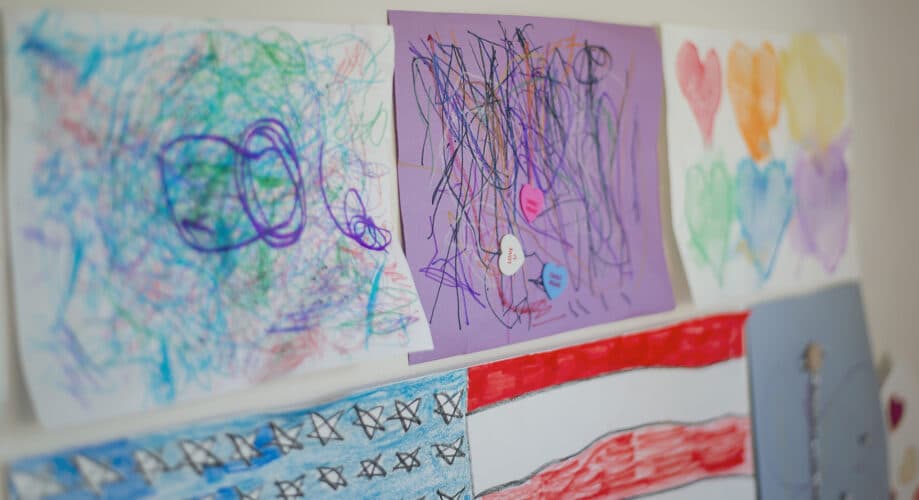
Regular communication between educators and families is key to forming meaningful relationships and partnerships. Parents love to know how their children are doing and what they are learning, and they appreciate hearing stories about their child’s activities and accomplishments. In this article, we highlight a few simple strategies for connecting with families by sharing information about the skills their little ones are building throughout the day.
Young children benefit when their parents and caregivers work together to support their development and learning. Communicating with parents about their child’s play and learning experiences in your program leads to positive parent-educator partnerships based on trust.
When parents hear about all of the skills that their child is developing, they feel a sense of involvement and enthusiasm about their child’s learning. These types of interactions with parents can open the door to conversations that create a connection between learning at school and learning at home. For example, when sharing examples of the topics and activities that their child seems to find engaging at school, you might ask parents about what their child enjoys doing at home. Together, you and the parents can talk about how children might practice the skills they are developing at school while they have fun playing at home.
Frequent updates to parents about their child’s engagement in playful learning is also a way to communicate the thoughtfulness and intention that you and your team put into planning a curriculum filled with activities that are meaningful, engaging, and educational.
Below are some approaches that might help you showcase children’s learning and keep families connected to the classroom experience. These strategies provide an opportunity to highlight and celebrate all the important skills children are developing through play.
One of the simplest ways to let parents know about their children’s work is to display it in the classroom. Hang each child’s completed artwork in a visible location, so parents can see it when they come in during drop-off and pick-up time. You might also print photos of the children working on the displayed project alongside the completed work so that parents get a glimpse into the process.
It can be especially helpful to post a small description next to the artwork that highlights the skills the children practiced as they created their artwork. For example, you might place a small sign describing the fine motor skills children practiced as they worked with stickers, tape, and crayons. Or, you can make a sign that names the specific activity, such as process art, and includes a sentence or two about the foundational skills children build through that activity. This helps parents to gain a better understanding of the importance of these activities and the way that play supports development.
A fun way to invite parents into their children’s learning is to display some of the books that children have been enjoying in your classroom. You might put a book next to your sign-in/sign-out sheet with a note that says, “We’ve been really enjoying this book lately! When we read this story, we get to learn about…” By regularly rotating the featured book, you can highlight the variety of stories that children are enjoying and offer parents some insight into all of the different skills that children are learning during storytime.
Featuring a book in the sign-in area offers an opportunity to strike up a brief conversation with parents about a story or topic their child was particularly interested in, or about the way a child counted or rhymed with a story. Sharing this information might even inspire parents to incorporate similar books at home!
While parents might have a clear sense of their child’s pre-reading and writing skills, they are not always aware of the social-emotional skills their child is developing. As educators, we can update parents about the SEL skill-building that is happening in our classrooms and highlight the contribution SEL skills make to academic readiness.
Some elements of social-emotional learning, such as identifying and naming feelings, lend themselves to classroom displays, while others can be shared with families in a memo or conversation. You might, for example, let parents know that their children are practicing a particular SEL skill, such as turn-taking. Or, you might discuss SEL skills such as kindness, compassion, and empathy, and share examples of where you have seen these displayed among the children in your care.
Calling attention to social-emotional learning helps to remind parents about the wealth of individual and interpersonal learning that happens in your program. Play activities that support academic skills and play activities that support social and collaborative skills all contribute to kindergarten readiness and ongoing academic success.
There are many ways to share updates with parents, from a parent communication app to a newsletter, or even a whiteboard displayed in a location that is visible to parents. To maintain an ongoing connection with parents, it is important to communicate regularly, and as frequently as possible.
You’ll want to select a format that allows you to share information about children’s activities and the learning that is taking place through those activities. For example, you might write, “This week we took a nature walk in the yard to observe wildlife. We saw birds, bugs, butterflies, and several different plants! We then drew pictures of our observations. This was a fun way to explore some basic concepts in biology, such as seasonal plant life, animal habits, and more!”